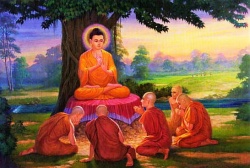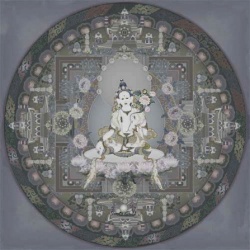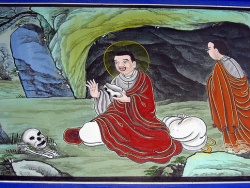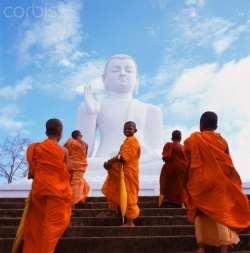Difference between revisions of "Women in vajrayana buddhism"
(Created page with " <poem> Buddhism is sometimes given a bad rap by women for being {{Wiki|male}} dominated and misogynistic. For instance, there are some Buddhists who say that the on...") |
|||
| Line 1: | Line 1: | ||
| − | + | {{DisplayImages|1326|235|1689|1749}} | |
<poem> | <poem> | ||
[[Buddhism]] is sometimes given a bad rap by women for being {{Wiki|male}} dominated and misogynistic. For instance, there are some [[Buddhists]] who say that the only way to attain [[enlightenment]] is to be [[reborn]] as a {{Wiki|male}}, and in the [[Vinaya]], the [[monastic code]] of conduct, women have more [[vows]] than men. [[Buddhist]] leaders in {{Wiki|Asian}} countries are almost always men. Is it true then that [[Buddhism]] is anti-women? | [[Buddhism]] is sometimes given a bad rap by women for being {{Wiki|male}} dominated and misogynistic. For instance, there are some [[Buddhists]] who say that the only way to attain [[enlightenment]] is to be [[reborn]] as a {{Wiki|male}}, and in the [[Vinaya]], the [[monastic code]] of conduct, women have more [[vows]] than men. [[Buddhist]] leaders in {{Wiki|Asian}} countries are almost always men. Is it true then that [[Buddhism]] is anti-women? | ||
Latest revision as of 02:13, 7 December 2013
Buddhism is sometimes given a bad rap by women for being male dominated and misogynistic. For instance, there are some Buddhists who say that the only way to attain enlightenment is to be reborn as a male, and in the Vinaya, the monastic code of conduct, women have more vows than men. Buddhist leaders in Asian countries are almost always men. Is it true then that Buddhism is anti-women?
In Vajrayana Buddhism, women have always played key roles. Padmasambhava (Guru Rinpoche), the Indian tantric master who introduced Vajrayana into Tibet, had many consorts. Among these were two who played pivotal roles in his teachings. One was the Princess Mandarava of Zahor in India who chose the Dharma over wealth and power that was hers for the taking if she had so chosen. Padmasambhava came to Zahor specifically to teach her and make her his consort. After some initial problems with her family (her father attempted to burn him at the stake when he found him in her quarters), Mandarava was allowed to become his consort. Padmasambhava took her to Maratika Cave in Nepal where they accomplished the unified vajra body of life mastery as master and consort. She is considered to be a wisdom dakini who has manifested numerous times, including the yogini Mirukyi Gyenchen, Risulkyi Naljorma, Drubpey Gyalmo, Niguma, and Chusingi Nyemachen, the consort of Maitripa. Jetsunma Ahkön Lhamo has been recognized as an emanation of Mandarava.
The other principal consort of Padmasambhava was Yeshe Tsogyal, a highly realized Tibetan yogini. Originally one of King Trisong Deutsen’s queens, she later became Padmasambhava’s spiritual consort. She was responsible for compiling the inconceivable teachings of Guru Rinpoche and assisted him in hiding termas (hidden treasures) throughout Tibet and surrounding countries to be revealed in later times when they would be of supreme benefit. According to Jamgon Kongtrul, she was “a direct incarnation of Vajra Varahi.” Padmasambhava considered the accomplishment of both Mandarava and Yeshe Tsogyal to be the equivalent of his own. Thus two of the foundational figures of Vajrayana Buddhism were highly accomplished women.
The history of Vajrayana in Tibet and other countries where it flourished, such as Mongolia, Nepal and Bhutan, is replete with stories of highly accomplished female practitioners or yoginis. Among these, the great yogini Machik Labdron is particularly significant. Said to be a reincarnation of Yeshe Tsogyal, she studied under Phadampa Sangye, a great master believed to be the reincarnation of Padmasambhava. She originated and propagated the Chöd practice, the only Vajrayana practice to originate in Tibet and spread to India rather than vice versa. Tsultrim Allione, a Western female lama, has been recognized as an emanation of Machig Labdron.
These are but a few of many highly realized female practitioners in the history of Vajrayana. They make up an important and vital segment of the fabric of Vajrayana. But beyond the historical figures, there are also a number of female Buddhas and dakinis (female wisdom beings) that are included in Vajrayana deity practice, Buddhas such as Tara, the female Buddha known as Mother of all Buddhas as she represents enlightened wisdom. She is said to have sprung from the tears of Avalokiteshvara (Chenrezig in Tibetan), the bodhisattva of compassion, as he looked out upon the suffering in the world. In other stories she is said to be a fully enlightened Buddha who, when she was an ordinary sentient being striving for enlightenment, was told that she could only attain enlightenment as a male. Therefore she made a vow to attain enlightenment and always return in a female form for the benefit of sentient beings – the ultimate feminist!
Protectors of the Dharma in Vajrayana at times appear in female form, such as Palden Lhamo. She is the consort of Mahakala and is the tutelary deity of Tibet. She is closely identified with the Dalai Lamas.
For the ordinary practitioner, the role of women in Vajrayana Buddhism is equivalent to that of men. While it is true that in Tibet monastic institutions were nearly always headed by men, female practitioners were greatly respected and revered. For example, Genyenma Ahkön Lhamo, the sister of Kunzang Sherab, first throneholder of the Palyul lineage of the Nyingma School, was widely considered to be a living saint during her lifetime. So many nuns came to hear her teachings and practice with her that the hills around the cave in which she lived in retreat became known as the “Red Hills”, a name which persists even today.
Women are considered to be superior practitioners to men as they are said to have a greater capacity for wisdom. In the Vajrayana view, the female is symbolic of wisdom, while the male is symbolic of compassion, which is somewhat opposite of the way the sexes are viewed in the West. The union of the male and female principles, compassion and wisdom, is known as bodhicitta and is enlightenment itself.
Dakinis – enlightened female wisdom beings – are said to reveal the teachings to practitioners who are ready to receive them. Dakinis also represent the Three Roots as they may manifest as a guru, a yidam or a protector.
It is clear that women play a vital role in the practice of Vajrayana Buddhism and are essential to the attainment of the ultimate goal, enlightenment. Without them, there would be no Diamond Vehicle.
References
Lives and Liberation of Princess Mandarava, revealed by Samten Lingpa, translated by Lama Chonam and Sangye Khandro, Wisdom Publications, 1998
The Lotus-Born: The Life Story of Padmasambhava, recorded by Yeshe Tsogyal, translated by Erik Pema Kunsang, Shambhala, 1993
Lady of the Lotus-Born: The Life and Enlightenment of Yeshe Tsogyal, by Gyalwa Changchub and Namkhai Nyingpo, Padmakara Translation Group, Shambhala, 1999
The Biography of Machik Labdron (1055-1145), in Women of Wisdom, by Tsultrim Allione, Snow Lion Publications, 2000
In Praise of Tara: Songs to the Saviouress, by Martin Wilson, Wisdom Publications, 1992
The Religions of Tibet, by Giuseppe Tucci, University of California Press, 1970
Dakini’s Warm Breath: The Feminine Principle in Tibetan Buddhism, by Judith Simmer-Brown, Shambhala, 2002



